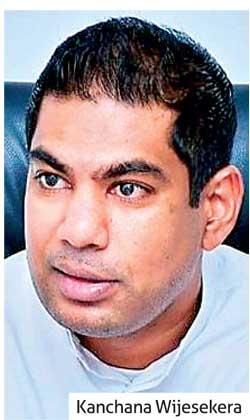30 May 2022 - {{hitsCtrl.values.hits}}
Proposed changes to electricity tariffs could triple the monthly electricity bills of the wider industrial and commercial segments at a time when they are scrambling even to stay afloat with dampened business incomes and skyrocketing costs which have killed their desire to remain in business.
 However, according to Power & Energy Minister Kanchana Wijesekera, their roof space could be used for rooftop solar power generation, a highly capital-intensive endeavour but could be financed using what they save from the current monthly electricity bill.
However, according to Power & Energy Minister Kanchana Wijesekera, their roof space could be used for rooftop solar power generation, a highly capital-intensive endeavour but could be financed using what they save from the current monthly electricity bill.
“They can invest the current electricity bill amount on solar panels to be paid monthly to the solar companies to lessen the burden on their institutes and also CEB grid,” Wijesekera said in a series of tweets announcing, in what is referred to as, “ a rapid renewable energy generation plan”.
In a two-pronged approach to tackle the current power crisis, Wijesekera proposed to convert the institutional sector power, including the government sector, into rooftop solar and, also to expedite the approval process for green energy projects.
“Provisional approvals to be granted immediately for proposed projects. Revise rates to reasonable,” he said.
“After provisional approval is issued, work with CEB, SEA and investors for transmission line and grid capacity enhancement with the required investment coming from the project investor,” he added.
However, it is often charged that the mafia operating inside the Ceylon Electricity Board (CEB) has prevented rooftop solar power generation from taking off, while the renewable energy projects are delayed due to alleged inefficiency, corruption, bribery and delaying tactics employed by the authorities in and outside the power and energy sector.
“Apart from the 2 quick steps, large scale investments for selected renewable projects will be accommodated after technical and financial evaluation,” the Minister further said.
Sri Lanka was forced to impose daily blackouts from the middle of February after the government ran out of dollars to pay for fuel imports to generate thermal power to make up for the cheaper hydro power which ran thin due to prolonged dry weather.
However, as the rain season arrived from May onwards increasing the hydro power generation capacity, the reliance on thermal power gradually reduced, enabling the authorities to reduce the power interruptions to a few hours.
As the country’s power generation is highly contingent on its climatic conditions, and the cost of thermal power generation is both expensive and has become nearly impossible due to the dollar shortage facing the country, the focus has now shifted greatly into renewable energy, predominantly through solar due to the country’s around the year dry weather.
According to Wijesekera, currently the monthly power generation cost exceeds US$ 100 million and the average per unit cost has climbed to Rs.48, causing the CEB to lose from every unit it sells.
This was reflected in the March interim results of the CEB, which made a massive loss at the gross profit level.
Under successive governments, Sri Lanka subsidised utilities as a vote buying gimmick but now the chicken is coming to roost at every household as the country’s economy made a hard landing in March and then declared bankruptcy in April.
09 Nov 2024 1 hours ago
09 Nov 2024 3 hours ago
09 Nov 2024 5 hours ago
09 Nov 2024 6 hours ago
09 Nov 2024 7 hours ago